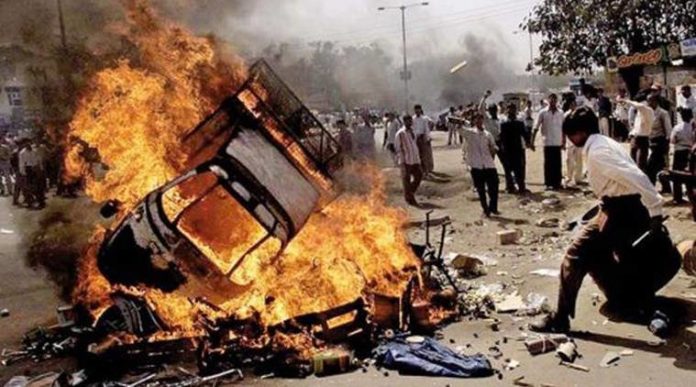– Dr. M. Iqbal Siddiqui
What happens when the world’s largest democracy becomes a battleground for engineered hatred? In India today, communal harmony – once its defining strength – is being systematically torn apart. In 2024, communal incidents surged by 84%, according to the Centre for Study of Society and Secularism (CSSS), with violent acts like the Aligarh lynching exposing a troubling pattern of orchestrated division. From mobs attacking innocents over unverified accusations to provocative displays of Pakistani flags, these incidents are not random – they point to a systematic effort to polarise communities, particularly targeting Muslims. Confronting this challenge requires understanding its roots, acknowledging its impact, and forging solutions grounded in justice and unity.
Historical Playbook: Tactics of Division
The seeds of communal discord in India trace back to the tumultuous days of Partition, when divisive tactics were honed to inflame religious tensions. Historical accounts reveal how groups disguised their identities to incite violence, a strategy that echoes in today’s provocations. The 1970s novel Tamas by Bhisham Sahni vividly captures this, depicting a Dalit manipulated into killing a pig to spark riots – a chilling parallel to modern acts designed to exploit societal fault lines. These historical tactics have evolved and are now amplified by social media and political rhetoric, to sow distrust and fracture India’s secular ethos.
A Wave of Provocations: Recent Incidents
Communal violence surged in 2024, with 13 mob lynchings – nine targeting Muslims over baseless allegations. The May 24, 2025 Aligarh lynching stands out: four Muslim youths were brutally attacked by a mob led by members of a communal group, accused without evidence of “cow slaughter.” One victim lay unconscious near a police vehicle, yet no immediate arrests were made. A survivor alleged that the assault continued in the presence of police – raising serious questions about law enforcement’s role.
Similarly, in Chhapra, Bihar, Zakir Qureshi was lynched on May 11, 2025, with a viral video contradicting police claims of a personal dispute. In Mangaluru, Karnataka, a Muslim man was killed during a cricket match in April 2025 over unverified claims of “Pakistan Zindabad” slogans.
Beyond lynchings, provocations have deliberately stoked tensions. In Akbarpur, West Bengal, two men from a fringe group were arrested on May 1, 2025 for planting Pakistani flags in a railway toilet and scrawling inflammatory slogans. Similar staged incidents occurred in Rishikesh, Uttarakhand, where flags appeared on streets as a fake “protest” after the April 22 Pahalgam terror attack.
In Kalaburgi, Karnataka, Bajrang Dal activists pasted Pakistani flag stickers at public junctions, allegedly as a response to terrorism – furthering communal fear. Vadodara, Gujarat, witnessed similar flag posters, sparking outrage and suspicion of deliberate incitement. These events, in both BJP-ruled states and elsewhere, point to a concerted effort to exploit national tragedies and deepen communal divides.
Mechanics of Communal Tension: A Systemic Breakdown
Communal tensions in India are sustained by a nexus of interrelated forces, each intensified by recent developments:
- Political Rhetoric: Hate-filled speeches by political leaders normalise suspicion and justify vigilante actions. In April 2024, Prime Minister Narendra Modi, at a rally in Rajasthan, labelled Muslims as “infiltrators,” triggering over 300 hate speech incidents in just 43 days. Uttar Pradesh Chief Minister Yogi Adityanath, in 86 speeches throughout the year, promoted conspiracies like “love jihad,” painting Muslims as a threat to Hindu identity. Himachal Pradesh, though under Congress rule, saw a 269% rise in hate speech during mosque-related protests, directly linked to BJP rhetoric. This language, especially during election campaigns, emboldens hostility and often precedes violence.
- Vigilante Violence: Right-wing groups such as Bajrang Dal, Vishwa Hindu Parishad, and Gau Raksha Dal exploit laws like those on cow protection to justify assaults. In August 2024, a 26-year-old Muslim worker was lynched in Haryana over alleged beef consumption, while a Hindu teen, mistaken for a Muslim, was shot dead. In Ambala, Gau Raksha Dal publicly abused Muslim truck drivers with police support, despite no evidence of wrongdoing. In Karnataka, Puneeth Kerehalli’s group was linked to the torture and murder of Idrees Pasha. These groups act with impunity, often livestreaming assaults, as seen in 48 communal incidents in coastal Karnataka in 2024 alone.
- Media and Social Media: Communal sentiments are inflamed by sensationalism and viral misinformation. After the Pahalgam attack, false claims linking Muslims to terrorism spread rapidly on platforms like X and WhatsApp. India Hate Lab recorded 995 hate speech videos on social media in 2024 – 98.4% remained online, despite policy violations. During the 2024 elections, BJP’s IT cells flooded digital spaces with unverified claims about a Muslim “vote jihad,” accounting for 41.4% of Google’s political ad spending. Misinformation around a stabbing in Puttur, Karnataka, falsely framed as communal, led to unrest. India’s top rank in the 2024 Global Risk Report for misinformation highlights the gravity of the issue.
- State Complicity: A disturbing pattern of institutional apathy and selective enforcement has taken root, enabling communal violence and eroding public trust in democratic safeguards. Police inaction and selective enforcement reinforce a climate of impunity. In May 2025, police failed to intervene during a lynching in Aligarh. In October 2024, vigilante violence in Jammu went unchecked. In Mandla, Madhya Pradesh, 11 Muslim homes were demolished in June 2024 after unproven beef allegations – “bulldozer justice” without due process. The Election Commission’s silence on 269 hate speech cases during the 2024 elections further eroded trust. The National Human Rights Commission’s deferred accreditation in May 2024 underscored institutional failure to address these violations.
- Silence and Suppression of Solidarity: Apathy and trolling often silence voices calling for unity. After the Pahalgam attack, families of victims – including widows from the armed forces – urged citizens to reject communal polarisation and applauded Kashmiri civilians who helped during the tragedy. Yet, they were met with online abuse, illustrating how deeply entrenched communal narratives are – and how hard they are to challenge.
Human and Societal Toll
The impact of these tensions is profound. Communal incidents have driven a wedge between communities, with 74% of Indians reporting heightened tensions in 2024, according to Pew Research. Muslims, in particular, face fear, economic exclusion, and stigma, with nine of 11 lynching deaths targeting them. This marginalisation erodes their sense of belonging in a nation meant to uphold equality. The broader societal cost is the weakening of India’s secular fabric, as divisive forces push a vision that contradicts the constitutional commitment to pluralism. When mobs act with impunity and institutions falter, trust in the rule of law diminishes, threatening the very foundation of India’s democracy.
Reclaiming Harmony: A Path Forward
Confronting this crisis demands collective action rooted in justice and compassion. The systematic fomentation of communal tensions – through lynchings like Aligarh, staged provocations like Pakistani flag displays, and unchecked rhetoric – poses a grave threat to India’s pluralistic ethos. Yet, the resilience of communities, as seen in the unity displayed by Pahalgam victims’ families, offers hope. Here are actionable steps to restore harmony:
- Strengthen Legal Accountability: Enforce stringent laws under the Bhartiya Nyay Sanhita and Unlawful Activities (Prevention) Act to punish hate crimes and communal provocations. The NIA push for maximum punishment in the 2008 Malegaon bomb blast case, targeting Hindutva-linked perpetrators, sets a precedent. Uniform compensation for lynching victims and fast-tracked trials can deter future violence.
- Foster Interfaith Dialogues: Community-led initiatives can bridge divides. Drawing inspiration from Kashmiri civilians’ aid to Pahalgam victims, interfaith forums can promote mutual understanding, countering narratives of hate.
- Promote Responsible Journalism: Media outlets must prioritise truth over sensationalism. Radiance can lead by debunking misinformation, such as false narratives around flag incidents, and amplifying stories of unity, continuing its 60-year legacy of ethical reporting.
- Empower Youth: Invest in education and skill development for Muslim youth, equipping them to resist divisive narratives through civic engagement and leadership. Programmes in states like Telangana show how economic inclusion can strengthen community resilience.
- Encourage Community Vigilance: Citizens must remain alert to staged provocations, such as flag displays or false accusations, reporting them promptly to authorities. Grassroots networks can work with police to prevent riots and ensure swift action against perpetrators.
Let’s stand for justice, reject division, and rebuild trust through dialogue and action.




